Essential Spices: An Introduction
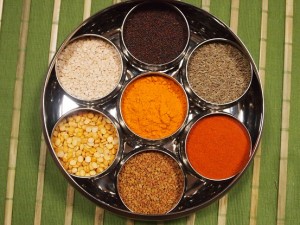
Herbs, spices and powdered spice blends hold a special place in all of Indian cooking — vegetarian and non-vegetarian, northern and southern, eastern and western. It is a rare dish that is not livened up with some sort of herb, fresh spice (such as green chilies), dried and roasted or ground spices. In my home state of Karnataka, even buttermilk, for example, served primarily at the end of a meal, is flavored with salt, chopped coriander or mint, grated ginger and topped off with a tempering made of a little bit of oil, curry leaves, mustard seeds and cumin seeds.
Indian cuisine is vastly diverse, not only in terms of ingredients, traditions, and techniques, but also in terms of levels of complexity — ranging from simple curries and chutneys to the biryanis that demand multiple discrete steps and hours to cook.
Most Indian home cooking, however, particularly vegetarian home cooking, boasts of a repertoire of recipes that allow one to achieve sophisticated flavors with a few basic fresh and dry spices and herbs. Those recipes and a few slightly higher on the complexity spectrum — from the South Indian kitchens of my childhood and now my own — will be the focus of this essay and the ones that follow.
Fresh herbs and spices most prevalent in South Indian cuisine, such as cilantro, mint, garlic, ginger and green chilies, are available at any grocery store. These days, even the dry Indian spices are easy to find — neatly packaged and labeled — in Indian grocery stores all over the world. The recipe for potato and onion curry that follows uses a few of these essential dry spices that play starring roles in South Indian vegetarian home cooking.
Asafetida, when raw, exudes an intensely pungent odor. The product of a plant native to Persia, it is used in its powdered form or in small granular form and heated in oil or ghee before adding to a dish. When cooked, it releases an aroma very similar to roasted onions or garlic, which is why those whose faith practices forbid the use of onions or garlic use asafetida instead in dishes made for festivals or religious rituals. I love asafetida’s aroma and am prone to using it even with onions and garlic. Note that asafetida is combined with wheat starch so it flows easily from the container. If you are following a gluten-free diet, it’s best not to use it.
Coriander Seeds/Cilantro. Cilantro is a fresh herb used as garnish or in wet spice mixes. The seeds of this plant (coriander seeds), roasted and ground, are also widely used in everyday dishes and in spice blend powders.
Chilies are available in various colors, shapes and sizes. Fresh chilies are green and depending on their size, range from extremely spicy to mild. The longer, thicker ones tend to be milder while the tiny ones tend to pack the most heat. Among the dried red chilies are the straight, smooth ones that are deployed for their spiciness, whereas the gnarly, crooked ones (Byadgi, grown in the areas in and around the town of Byadgi in the Haveri district of Karnataka) are mainly used for their color. The latter impart an intense red color to the dish while being milder on the heat scale. It is not uncommon for cooks to use a combination of the two types of red chilies to achieve spiciness while not sacrificing color. The first harvest of the Byadgi variety is also favored for making Ranzak, a fiery red chili pickle very popular in North Karnataka.
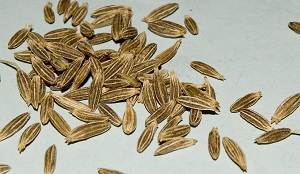
Cumin is the dried seed of the cumin plant. The seeds are tiny, tubular, ridged and a dull brown color. This spice is used widely the world over, from Asia to Europe to Latin America. You’d be hard-pressed to find a Karnataka dish that does not incorporate cumin in some form, either whole or ground. Roasting, crackling cumin exudes a warm scent that fills a home and brings good tidings of an impending meal to hungry stomachs.
Curry Leaves appear to be the darker versions of neem leaves. The leaves come from a relatively small tree and are a bright green when tender which gradually darken as they grow bigger. Highly fragrant, fresh curry leaves are a staple in tempering. While many of us tend to discard the leaves while eating, die-hard curry leaf fans extol their digestive properties and eat it with gusto. Curry leaves are also dried and powdered to make a delicious powder blend that is eaten with steaming hot rice and ghee.
Fenugreek is a popular ingredient in Karnataka cuisine, especially in North Karnataka, both as fresh greens and in its dried seed form. The leaves are mildly bitter. They are used in curries, and cooked with dal to make staple North Karnataka dishes such as Muddi Palya or Huli Palya. The seeds are nearly square, are a dull golden color and pack a far more bitter taste than the leaves. They are roasted before grinding to take out some of that bitterness. Roasted and ground, fenugreek seeds are used in chutneys and curries and add an interesting layer to the other base flavors. Fenugreek is also known to increase breast milk production in lactating mothers and is therefore an integral part of the ministrations showered on new mothers.
Garlic. The boat-shaped white cloves of garlic bulbs are widely used as flavoring agents and for medicinal purposes. Somewhat like the onion, garlic is spicy and pungent when raw, but when cooked gently (boiled, roasted or sautéed), becomes sweeter. It also has a tendency to turn bitter when overcooked. Garlic cloves are kept whole when the cook wants only a mild flavor, but are crushed, diced, sliced or ground to unleash a more intense flavor.

Ginger, when eaten raw, is yet another spice that packs heat, but is distinct from that of the heat in chilies, pepper or mustard. It is the rhizome part of the plant (like turmeric) and fresh ginger has an aroma unlike any other — spicy, earthy and slightly sweetish. The somewhat soft, bumpy skin when peeled away reveals a dull yellow, crunchy interior that grows more fibrous as the ginger ages. When buying ginger, it is best to look for tubers that are firm to the touch and whose skin appears translucent and moist. Ginger is used ground, grated or chopped into a fine dice. It is said to counter the gas generating properties of beans and lentils. It is also used in home remedies for the common cold. When used in large quantities (as in Ginger Pickle), the recipes usually call for copious amounts of jaggery to counter the pungent spiciness of the ginger.
Jaggery is boiled, concentrated and solidified sugar cane syrup. Unlike sugar, jaggery retains the molasses along with the sugar crystals (and is therefore found in various shades of brown) and more of the minerals found in sugar cane. As such, jaggery is thought to be healthier than refined sugar. Jaggery use is more prevalent in North Karnataka cuisine than it is in the cuisine of South Karnataka, perhaps because the former is influenced to a larger extent by the cuisine of Maharashtra (which borders the North Karnataka region), where jaggery is very popular. The sweetness in the jaggery is used not only to balance out the other more prominent flavors in North Karnataka cuisine, such as saltiness, sourness, and spiciness, it is also used on religious occasions and in social gatherings as a sweet offering to guests and to members of the family.
Mint. Slightly sweet, slightly spicy, intensely aromatic, fresh mint leaves add a fantastic layer of flavor to a dish. When making chutney, the leaves are roasted slightly to encourage the flavor to intensify. Mint leaves are best used within a couple of days of buying from the market. Even in the refrigerator, they tend to turn dark after two or three days.
Mustard Seeds are tiny, round and are available in different colors — white, yellow, a grayish black and black. The kind used most in South Indian cuisine are the latter two. The seeds come from the mustard plant. They may be diminutive, but they pack quite a punch in terms of spiciness, the kind that is pungent and hits you between the eyes. They are used in small quantities in tempering for nearly every type of savory dish, so much so that it feels really odd to see a dish with no trace of mustard seeds in it. Outside of the tempering, raw, powdered mustard seeds are used to add pungent heat to otherwise mildly spiced dishes (such as Cluster Beans Curry with Curds), or to add an additional layer of spiciness — distinct from the kind you get in chilies — in pickles.
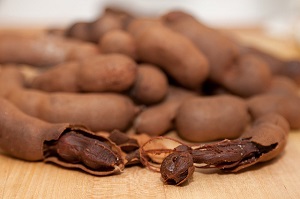
Tamarind is the fruit of the Tamarind tree, brown in color and pulpy. The fruit is intensely sour to the taste. At the time of harvesting, the slightly tough outer layer is peeled, the fruit is seeded (or not) and dried, and sold in slabs or by weight. Tamarind plays a starring role in many a staple South Indian dish (savory gravies such as rasam and sambhar and condiments such as chutney and gojju). Tamarind paste, which is a ground concentrate of the fruit, is also available in grocery stores. It is almost always better to soak the dried tamarind fruit in warm water and use the resulting juice while cooking rather than the paste because the paste tends to impart too intense a flavor to the dish overwhelming all others.
Turmeric is the rhizome of the turmeric plant which belongs to the ginger family. Turmeric powder is obtained from boiling, drying and grinding the dried rhizome. The powder is a deep, rich yellow color and gives off an earthy, woodsy aroma. Turmeric powder is used to impart a mustardy color to dishes such as dals and sambhar and curries by adding to the tempering or to dal when it is boiled and for its antiseptic medicinal properties. It is used in various Hindu rituals, in weddings and other celebrations.
Not too long ago (and even now in the smaller towns and villages in India and in areas of cities with open air markets and weekly fairs), the gandiga or spice merchant was still the go-to person. In the large municipal markets a spice shop is instantly recognizable by the eye-catching display of conical mounds of vermilion, turmeric and betel nuts arranged enticingly at the front of the shop, and by the intense aroma of herbs and scents that tantalize your nostrils. A gandiga sells not only spices, but also religious ritual items such as cotton wicks, camphor, vermilion, turmeric, home remedies and incense sticks. In a typical shop, set a little ways away from the front of the store might be a large wooden crate, open at the top and neatly divided into several small sections, each section holding a spice.
Most dry spices can tolerate being stored in open top containers because they release their aromas and flavors only when roasted or ground. That can mean only one thing. Storing Indian spices at home for long periods is a breeze.
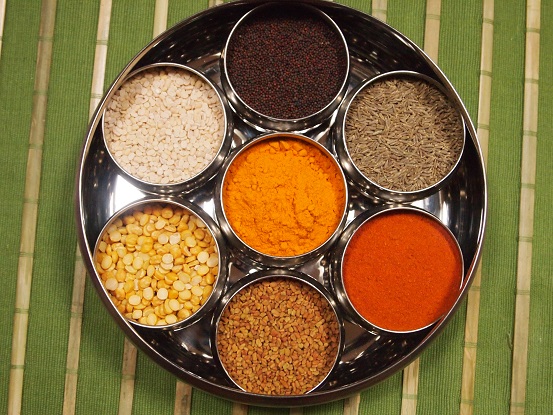
Potato and Onion Curry
Makes 4 servings as the main accompaniment to bread
or 8 servings as a side dish.
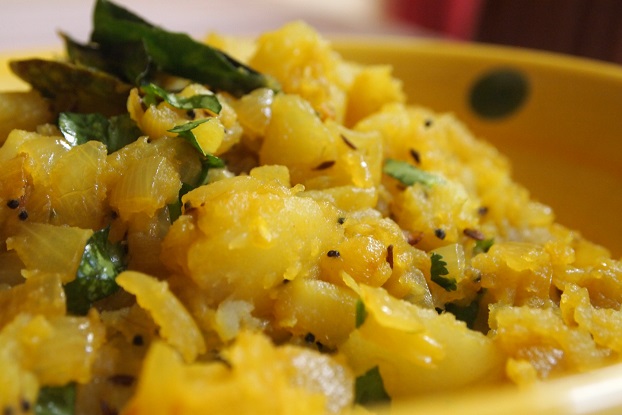
Ingredients:
4 tsp oil
½ tsp mustard seeds
¼ tsp cumin seeds
¼ tsp turmeric
3 or 4 green chilies, slit lengthwise
8-10 curry leaves
3 large potatoes, boiled, peeled and smashed into bite-size, chunky pieces
2 medium-sized onions, chopped into a small dice
2 tbsp grated fresh unsweetened coconut (optional)
Salt, to taste (about ¾ to 1 tsp)
1 tbsp chopped coriander leaves
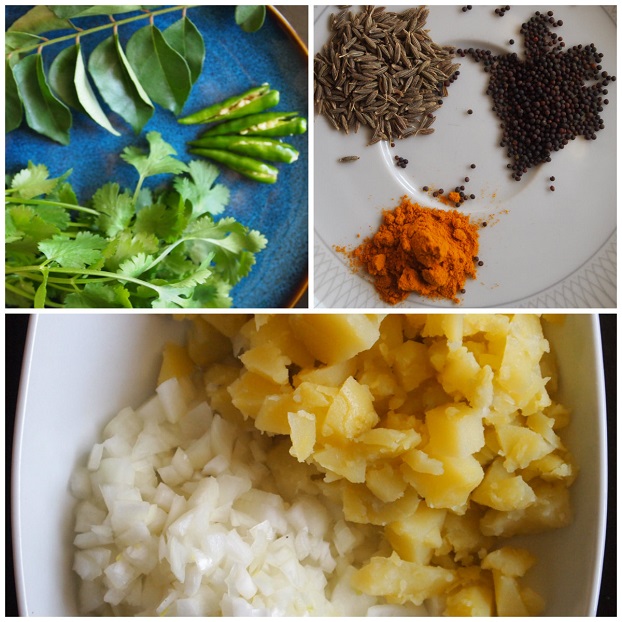
Method:
Heat the oil in a large, heavy frying pan over medium-low flame to shimmering. A wok works best. Add mustard seeds, wait for about 25 seconds and then add the cumin seeds. You will hear the mustard seeds crackling. After about 15 seconds, add the turmeric, chilies and curry leaves and sauté for about 30 seconds. (Mustard seeds and slit chilies are notorious for splattering, so close the pan with its lid each time — as soon as you add the mustard seeds and after you add the chilies.) This initial prep before adding the main ingredients is the ‘tempering.’
Add the onions and sauté on a medium-low flame until they turn translucent and golden, about 15 to 20 minutes. Add the potatoes, coconut (if using), and salt and mix well to blend all the ingredients. Sprinkle a little water if the curry feels dry. Cover and let cook for about 5 to 7 minutes. Turn off the stove, transfer the curry to a serving bowl, garnish with coriander leaves and serve.
Serving Suggestion:
Serve with naan or other types of flatbread. You could also serve this curry with lightly toasted pita wedges or in a healthy sandwich for a school lunch or snack. If you are going to be serving the curry to children or someone who’s not used to spicy foods, remove the green chilies and curry leaves from the finished curry and discard them.
For the sandwich, take two slices of whole wheat bread, lightly butter the outsides and spread a layer of the potato curry on one slice. Place the other slice on top (with the buttered side on the outside) and toast over a hot griddle, pressing down on the sandwich as you would for a grilled cheese sandwich. If you have a stove-top grill or a Panini Press, use it. And if you serve the sandwich with tomato ketchup, I promise not to tell.
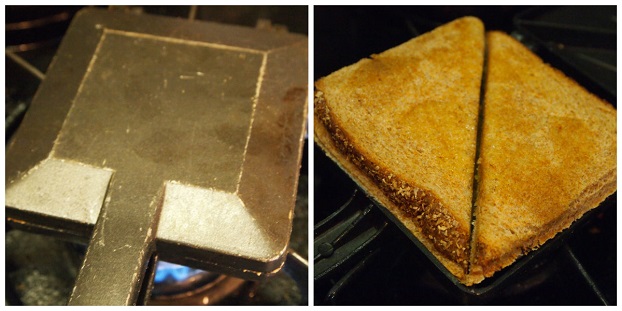
Most Indian stores also carry a sandwich maker which fuses the two bread slices, holds in the curry and makes it easy for little hands to hold the sandwich. Bread slice sizes in the US are just a tad too large for the sandwich makers, so just make sure you scrape off any crust that spills out when you close the two sides shut. If not, you’ll be left with bread crust falling into the flame and burning which is neither a pleasant sight nor smell.
Obviously, you could use the sandwich maker for other not-too-thick sandwiches in your repertoire as well.
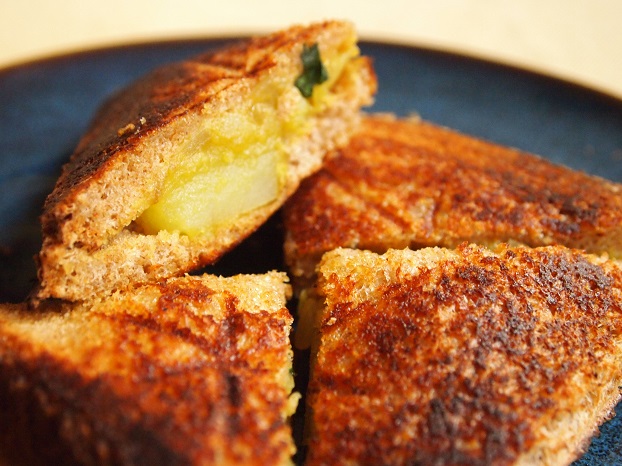
* * *
Sujatha Bagal is a Washington, D.C.- based freelance writer and blogger. Her essays, articles and stories have appeared in various online and print publications, including Pregnancy, Mint Lounge, ForbesLife India and The Smart Set (links available here). She is currently working with her mom-in-law on a cookbook featuring regional Karnataka cuisine. Find her onTwitter and Instagram.













Thank you for the beautiful, detailed descriptions of each spice and the fabulous recipe!
LTE, you’re welcome! I hope they get you going on a delicious journey.
I truly enjoy Indian cuisine. I love working with all the spices and flavors. A yellow curry served at a small restaurant near my home has become a favorite to savor. I’m thinking it is time to get back in the swing of cooking it. Thank you for the recipe.
Julie, fantastic! Holler if you have questions.